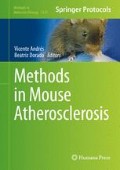Abstract
Small arteries play an important role in regulation of peripheral resistance and organ perfusion. Here we describe a series of methods allowing measurements in pressurized segments of small arteries from the systemic and coronary circulation of mice as well as other species. The pressure myography techniques described include measurements of wall structure, wall stress, strain, and myogenic tone. The pressurized perfused small arteries also allow evaluation of responses to increases in pressure, flow, and drugs, where the main readout is changes in vascular diameter.
Access this chapter
Tax calculation will be finalised at checkout
Purchases are for personal use only
References
Mulvany MJ, Aalkjaer C (1990) Structure and function of small arteries. Physiol Rev 70:921–961
Duling BR, Gore RW, Dacey RG Jr et al (1981) Methods for isolation, cannulation, and in vitro study of single microvessels. Am J Physiol 241:H108–H116
Mulvany MJ, Halpern W (1977) Contractile properties of small arterial resistance vessels in spontaneously hypertensive and normotensive rats. Circ Res 41:19–26
Buus NH, VanBavel E, Mulvany MJ (1994) Differences in sensitivity of rat mesenteric small arteries to agonists when studied as ring preparations or as cannulated preparations. Br J Pharmacol 112:579–587
Schubert R, Wesselman JP, Nilsson H et al (1996) Noradrenaline-induced depolarization is smaller in isobaric compared to isometric preparations of rat mesenteric small arteries. Pflugers Arch 431:794–796
Paniagua OA, Bryant MB, Panza JA (2001) Role of endothelial nitric oxide in shear stress-induced vasodilation of human microvasculature: diminished activity in hypertensive and hypercholesterolemic patients. Circulation 103:1752–1758
Edwards G, Dora KA, Gardener MJ et al (1998) K+ is an endothelium-derived hyperpolarizing factor in rat arteries. Nature 396:269–272
Miura H, Wachtel RE, Liu Y et al (2001) Flow-induced dilation of human coronary arterioles: important role of Ca(2+)-activated K(+) channels. Circulation 103:1992–1998
Schjorring O, Kun A, Flyvbjerg A et al (2012) Flow-evoked vasodilation is blunted in penile arteries from Zucker diabetic fatty rats. J Sex Med 9:1789–1800
Hernanz R, Martin A, Perez-Giron JV et al (2012) Pioglitazone treatment increases COX-2-derived prostacyclin production and reduces oxidative stress in hypertensive rats: role in vascular function. Br J Pharmacol 166:1303–1319
Roque FR, Briones AM, Garcia-Redondo AB et al (2013) Aerobic exercise reduces oxidative stress and improves vascular changes of small mesenteric and coronary arteries in hypertension. Br J Pharmacol 168:686–703
Thorsgaard M, Lopez V, Buus NH et al (2003) Different modulation by Ca2+-activated K+ channel blockers and herbimycin of acetylcholine- and flow-evoked vasodilatation in rat mesenteric small arteries. Br J Pharmacol 138:1562–1570
Stankevicius E, Dalsgaard T, Kroigaard C et al (2011) Opening of small and intermediate calcium-activated potassium channels induces relaxation mainly mediated by nitric-oxide release in large arteries and endothelium-derived hyperpolarizing factor in small arteries from rat. J Pharmacol Exp Ther 339:842–850
Christensen FH, Hansen T, Stankevicius E et al (2007) Elevated pressure selectively blunts flow-evoked vasodilatation in rat mesenteric small arteries. Br J Pharmacol 150:80–87
Acknowledgment
Ulf Simonsen is supported by the Danish Heart Foundation and is part of LiPhos (Living Photonics: Monitoring light propagation through cells), which is funded by the EC Seventh Framework Programme.
Author information
Authors and Affiliations
Corresponding author
Editor information
Editors and Affiliations
Rights and permissions
Copyright information
© 2015 Springer Science+Business Media New York
About this protocol
Cite this protocol
Schjørring, O.L., Carlsson, R., Simonsen, U. (2015). Pressure Myography to Study the Function and Structure of Isolated Small Arteries. In: Andrés, V., Dorado, B. (eds) Methods in Mouse Atherosclerosis. Methods in Molecular Biology, vol 1339. Humana Press, New York, NY. https://doi.org/10.1007/978-1-4939-2929-0_19
Download citation
DOI: https://doi.org/10.1007/978-1-4939-2929-0_19
Publisher Name: Humana Press, New York, NY
Print ISBN: 978-1-4939-2928-3
Online ISBN: 978-1-4939-2929-0
eBook Packages: Springer Protocols

